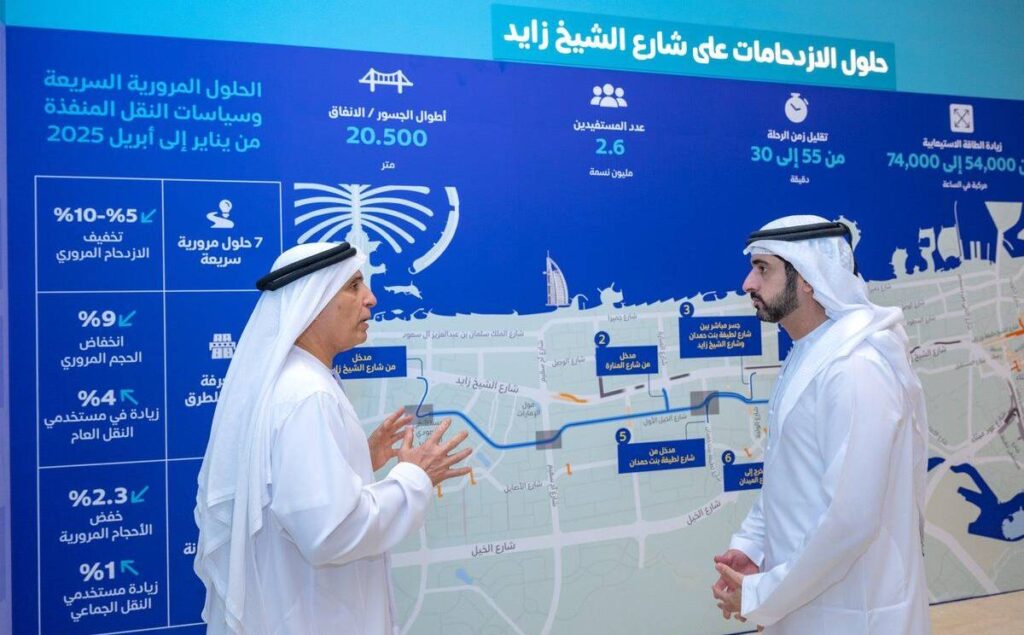Dubai: Dubai will change the way residents move around the city with a comprehensive infrastructure plan aimed at reducing travel time, improving sustainable mobility and creating chiefs for a population of 8 million.
His Highness Sheikh Hamdan bin Mohammed bin Rashid Al Maktum, Crown Prince Dubai, Deputy Prime Minister, Minister of Defense and Chairman of Dubai’s Executive Council have checked recent advances in high-end lettering of the Streets and Transport Authorities (RTA).
The 2025 2027 plan consists of 57 street development projects with 226 kilometres of new roads and 115 bridges and tunnels built. The initiative consists of Dubai Eight vertical and 11 horizontal primary corridors, with significant upgrades to major roads such as UMMS Al Qudra, Hessa Street and Al Fay Road.
Major roadworks
Development project UMMS Al Qudra Corridor is over 16 km and connects Jumeirah Street to Emirates Road. A 7,000-meter bridge and tunnel are being constructed on this important arterial route, with over 1 million residents. As soon as it is finished, road capacity increases from 8,400 to 12,600 cars per hour, with travel times being reduced by 46 minutes.
To accelerate progress, the large-scale project was split into three phases. The first phase covering the route from Alkhail Road to Sheikhmohamed Bin Zayed Road. This conversion makes traffic congestion considerably easier in some dense residential and development zones.
Work on Hessa Street, another critical artery, is 60% completed, with parts of the road currently accessible to traffic. The development includes 9,000 metres of bridges across four renovated crossroads. The completed route will treble its capacity from 4,000 to 8,000 vehicles per hour, reducing commuting times from 30 minutes to seven. These changes are expected to benefit around 640,000 residents.
A 13.5-kilometer cycle and e-scooter route from Al Sufouh to Dubai Hills is being built along Hessa Street as part of the sustainable transportation initiative. It comprises two distinctively constructed five-metre-wide bridges that cross Sheikh Zayed Road and Al Khail Road, featuring lanes for bikes, e-scooter riders, and pedestrians.
Smart mobility push
Sheikh Hamdan also evaluated the Al Fay Street Corridor Project, which serves as an expansion of Al Khail Road. It connects Sheikh Mohammed Bin Zayed Road and Emirates Road with Sheikh Zayed bin Hamdan Al Nahyan Street. The project consists of 12,900 metres of roadways and 13,500 metres of bridges crossing five crossroads. When completed, it will accommodate an additional 64,400 vehicles per hour and service about 600,000 people.
Sheikh Zayed Road, which is utilized daily by about 2.5 million people, has also benefited from swift mobility solutions implemented between January and April 2025. These included dynamic toll pricing, variable parking charges, and seven quick-fix remedies that resulted in a 5-10% reduction in congestion. Dynamic road tolls helped to cut traffic by 9%, while public transport ridership increased by 4%. Parking rate reductions also reduced traffic by 2.3% while increasing transit usage by 1%.
To improve efficiency and real-time project monitoring, the RTA has implemented modern technology such as AI and drone surveillance. These tools have doubled on-site monitoring, reduced field survey time by 60%, and improved overall decision-making. Time-lapse imaging now enables 24-hour oversight, increasing efficiency by 40% and minimizing delays by 20% by detecting problems early.
Future-ready transport
Sheikh Hamdan also went over the plans for launching driverless taxis in Dubai. Agreements have been struck with three foreign corporations to start operations in 2026. The project’s first phase involves the deployment of nearly 60 trucks for route mapping and data collection. Pilot operations will then begin in up to 65 pre-selected zones, each with an emphasis on safety, accessibility, and smart mobility potential.
This program is consistent with Dubai’s Self-Driving Transport Strategy, which seeks to convert 25% of all transport trips in the emirate to autonomous modes by 2030. The idea puts Dubai at the forefront of intelligent and sustainable urban transport.
Al Barsha 2’s Model District Project is shaping up to be a showcase for Dubai’s “20-minute city” idea. The effort aims to ensure that important services, such as schools, clinics, parks, and shopping centers, are within a 20-minute walk or bike ride of residential neighborhoods.
The district will have 17 kilometers of integrated cycling and pedestrian paths that will connect residents to significant destinations like as the Mall of the Emirates, Al Quoz Creative Zone, Dubai Hills, and Jumeirah Beach. Three communal spaces and rest stops are being constructed, with more vegetation, including around 590 new trees. Shaded smart seating and bike and e-scooter rental stations will also be available.
Dubai now has 557 kilometres of dedicated bicycle tracks. An additional 100 kilometers are under development, with 185 more planned. In 2024 alone, 47 million bicycle excursions were registered around the city. As part of its ongoing efforts to improve the user experience, Dubai intends to name its bike routes and increase private sector partnerships to provide related services and events.
